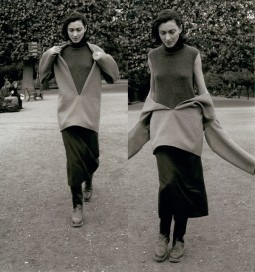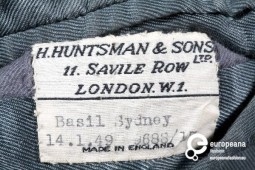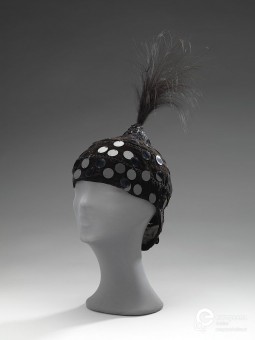Archive for April, 2017
Runway Archive: Valentino, Ready-to-Wear Winter 1979-1980

The image captures a moment of fun on the runway of the Valentino winter 1979-1980 collection. The models are wearing two total-black outfits, composed by an two different ‘little black dresses’, one made of velvet and the other probably of sheer silk, and pointed heels. The two outfit are completed by flamboyant hats and accessories.
The picture shows the two models dancing together: an interesting way to interpret the usual walk down the runway. The freedom and joy the image evokes might seem in contrast with the rather repetitive and rigorous parades at fashion shows. This has probably to do with the fact that the image comes from the show of a ready to wear collection: a different, more accessible line designed by Valentino, quite different from the couture. Through this line, the designer updated his definition of fashion, speaking to a wider audience and proposing another side of his personality to his public.
‘Margiela: The Hermès Years’ on Europeana Fashion Tumblr

This April, MoMu – Fashion Museum Antwerp curates the Europeana Fashion Fashion Tumblr with the images of its current exhibition ‘Margiela: The Hermès Years’.
From 1997 to 2003, fashion designer Martin Margiela, founder of the Maison Martin Margiela, has been the creative director of Hermès. These six years are narrated by MoMu – Fashion Museum Antwerp on our the Europeana Fashion Tumblr, in concurrence with the museum’s exhibition.
The curation features exclusive images illustrating the themes and the objects on display in the exhibition; alongside the pictures of the actual pieces, the curation includes selected photographs of the works of Martin Margiela for both his own Maison and for Hermès, to draw comparison and understand how these two brands influenced and quoted themselves, while designed by the same person.

Maison Martin Margiela A/W 1996-1997, Photo: Anders Erdström. Hermès A/W 1998-1999, Photo: Studio des Fleurs. ‘Margiela, The Hermès Years’, 31st March - 27th August 2017. Image courtesy MoMu - Fashion Museum Antwerp.
The exhibition displays in particular the connections through a selection of garments and accessories. the objects are put in dialogue in sections individuating the main themes and elements introduced and developed by Martin Margiela in his design practice, and how he declined them in his work.
For more information about ‘Margiela: The Hermès Years’, on show through the 27th August 2017, please visit MoMu’s website. Check out the Europeana Fashion Tumblr everyday not to miss a post!
THE EDITOR’S COLUMN: AUTHORSHIP

In fashion, names are crucial: the history of fashion was constructed on the names of the designers who shaped the most iconic silhouettes, or designed the unforgettable items that became symbols of their time. However, this kind of history is guilty of leaving behind some of the names whose role is not so visible, but still of invaluable importance.
Fashion objects themselves can be used to challenge this narrative, allowing us to discover new stories hidden behind the scenes of their production. What we consider fashion objects, be it clothes or accessories, are the end result of a process that involves many different actors. They originate from the encounter of different realities, sharing knowledge and abilities in order to produce something.
The visibility designers have nowadays turned them into public personae, whose image and name is directly linked to the aesthetic they develop in their work. The status of celebrities granted to designers has a flip side: it often ends up concealing the intricate network of artisans, technicians, manufacturers, producers without whom fashion could simply not be possible.
Fashion objects and their biographies can be used as tools to question the common definition of author, and make us rethink creation in terms of lively networks. The stories of the production of fashion items are interesting because they make us understand that every detail of an object comes out of a dialogue, a collaboration, a partnership.
Fashion materially explains that creativity has to be paired with technical rigour, savoir faire and craftsmanship. By choosing authorship as this month’s theme, we want to present some of the ways in which designers have constructed their image and exploited their visibility in order to make some statements through fashion. We also intend to look at the experiences and personal relationships behind the creation of beautiful objects.
Europeana Fashion Focus: Hat designed by Max Heymans, 1950s.

The picture shows a cocktail hat designed in the 1950s by Max Heymans, dubbed the ‘godfather’ of Dutch couture.
The hat is helmet shaped with no brims, and the back is longer that the front. It is made of velvet, and from the ornate top appears a tuft of black egret feathers. The hat is decorated with large sequins that don’t cover the hat with a regular pattern. The inside is unfinished, with no linings.
Dutch couturier Max Heymans has designed hats throughout all his life. First, for his mother when he was young and later for his clients. Although he was helped by milliners such as Suzanne Moulijn to realise his creations, his obsession had him developing his first silhouettes to accompany his headwear. Although still influenced by Parisian fashion, his collections reflected his own personal vision, darkened by the events of the Second World War. His fruitful career lasted from 1945 to 1997.





